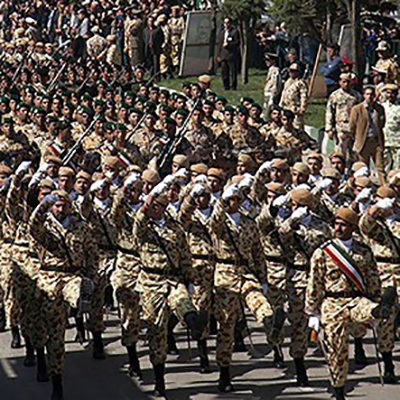Groups, Institutions, Organiza
Kermanshah 81st Armored Division
Mohsen Shir-Muhammad
171 Views
The 81st Armored Division, based in Kermanshah, is the main ground force unit of the Iranian Army in the country’s western region. During the Iran–Iraq War, it played a crucial role in this area, facing off against Iraqi military units.
The division was first established in 1934 as a brigade and later expanded into a full division. Because it was stationed near one of the main exit routes from Iran, the 81st Division was organized as an armored division equipped with some of the most advanced tanks of the time. In 1974, after Iraq claimed ownership of the strategic heights in Meimak, limited clashes broke out between the 81st Division and Iraqi forces. These skirmishes ended with Iraq’s defeat and eventually led to the signing of the 1975 Algiers Agreement.[1]
Following the Islamic Revolution and the onset of unrest in Kurdistan, units from the 81st Division were gradually deployed to this region. Also, the 2nd Armored Brigade of 81st Armored Division, based in Kermanshah, sent its forces—at platoon, company, and battalion levels—into troubled areas. Eventually, the unrest spread into Kermanshah Province itself, sparking conflicts in Paveh, Nosoud, and Javanrud, in which the 81st Division engaged.[2]
As Iraqi border violations escalated in 1980, other units of the division were deployed westward towards Kermanshah and Ilam provinces. Initially, the 3rd Armored Brigade, stationed at Sarpol-e Zahab garrison, was deployed along the border from Bawisi to Qasr-e Shirin to reinforce the troops in gendarmerie outposts. Later, the 1st Armored Brigade, based in Eslamabad-e Gharb, was dispatched to cover the border stretch from Qasr-e Shirin to Salehabad in Ilam.
When Iraq launched its full-scale invasion, the 81st Armored Division faced an unequal fight as it had to hold off at least one Iraqi armored division and one infantry division along a 500-kilometer front in western Iran.[3]
On September 23, 1980, following the outbreak of the Iran-Iraq War, a joint command center was established to better coordinate operations in the west (Kermanshah and Ilam). In addition to the 81st Division, a combat group of the 84th Infantry Brigade and several artillery units of the Maragheh and Isfahan 11th Groups were placed under this command.[4]
One of the division’s notable actions during this period was pushing back the enemy in October 1980. Located southeast of Sarpol-e Zahab and close to the Iraqi border, the troops positioned at Abu Zar Garrison managed to halt the enemy’s advance by the help of the Army Aviation.[5]
Once the enemy was pushed back, strengthening the 81st Division became the priority. The 2nd Armored Brigade was pulled from its security mission in Kurdistan and redeployed to Kermanshah where the 81st Division was active. In addition, about 30 percent of the division’s major equipment—tanks and armored personnel carriers—that had been sidelined in garrisons for repairs before the war, were restored and sent back into action.[6]
The division then launched several operations to reclaim occupied areas. For instance, operations Kalineh-Seyyed Sadeq (December 1980) and Tang-e Hajian (January 1981) were carried out in Dasht-e Zahab and Gilan-e Gharb, respectively.[7] Moreover, on January 9, 1981, when Operation Khwarazm was underway, the 1st Brigade of the 81st Division attacked the strategic Meimak Heights and, after defeating the enemy, fully secured the area.
Furthermore, engaging in operations Bazi Deraz (April and September 1981, Bazi Deraz Heights) and Matla al-Fajr (December 1981, Shiyakuh region) are all key measures taken by the division in the second year of the war.[8]
In October 1982, Operation Moslim ibn Aqil saw joint participation from the 81st Division and other Army and Islamic Revolutionary Guard Corps (IRGC) units. The division deployed three armored brigades and its newly formed mechanized brigade,[9] contributing to the successful liberation of the western mountains of Sumar.[10] Some of the division’s units were also deployed to the southern frontlines.[11] The 81st Division took part in Operation Kheibar (February 1984), which resulted in the capture of Majnoon Island.[12] Later, its artillery units provided critical fire support for IRGC forces during Operation Valfajr 8, which led to the capture of the Faw.[13]
In August 1987, during Operation Nasr 6, the 1st Brigade of the 81st Division joined other Army units in liberating parts of the Kalleh-Qandi Heights.[14]
Throughout the war, 3742 personnel and troops of the Kermanshah 81st Armored Division were martyred.[15] Ebrahim Bavandpour, Esmail Sohrabi, and Bijan Ettehadiyeh were the commanders of the 81st Armored Division during the Iran-Iraq War. Today, Brigadier General Hussain Sabzi serves as its commander.[16]
After the war, under the Samen Plan and the Army’s new structural reforms, the division’s brigades became independent: the 71st Abu Zar Brigade in Sarpol-e Zahab, the 181st Armored Brigade in Eslamabad-e Gharb, and the 282nd Armored Brigade in Bisotun. While operating independently, the units continue to fall under the 81st Division Headquarters for command coordination and mission oversight.[17]
[1] Mosht-e Pouladin-e Artesh dar Gharb (Iron Fist of the Army in the West), Mahname Saf, No. 372, Dey 1390, p. 18.
[2] Hussaini, Seyyed Yaqoub, Nabardhaye Sahne-ye Amaliyat-e Gharb (Battles in the Western Operational Zone), Tehran, Iran Sabz, 1395, p. 83.
[3] Ibi., Pp. 45, 83, 84.
[4] Ibid., Pp. 64, 104.
[5] Abedini, Marzieh, Padegane Abouzar (Abu Zar Garrison), Wiki Defa, https://wikidefa.ir
[6] Hussaini, Seyyed Yaqoub, Ibid., p. 282.
[7] Jafari, Mojtaba, Atlase Nabardhaye Mandegar (Atlas of Lasting Battles), Tehran, Soore Sabz, 35th ed., 1393, Pp. 34, 35.
[8] Ibid., Pp. 48, 59.
[9] Hussaini, Seyyed Yaqoub, Ibid., p. 542.
[10] Jafari, Mojtaba, Ibid., p. 82.
[11] Asadi, Heybatollah, Artesh dar Faw (The Army in Faw), Tehran, Iran Sabz, 1387, p. 125.
[12] Hussaini, Seyyed Yaqoub, Ibid., p. 573.
[13] Hussaini, Seyyed Yaqoub, Nabardhaye Sale 1362 ta Payane 1364 (Battles Took Place from 1983 to the Early 1986), Tehran, Iran Sabz, 1st ed., 1390, Pp. 340, 341.
[14] Jafari, Mojtaba, Ibid., p. 142.
[15] 10 Sale Defa Muqaddas dar Kermanshah, Khabargozariye Jomhouri Eslami (10 Years of Sacred Defense in Kermanshah), IRNA, 6 Mehr 1398, www.irna.ir/news/83493579
[16] Farmandeye Lashkare 81 Zerehiye Kermanshah – Amr be Mashverat dar Quran Karim Haman Jomhouriyat Ast (Commander of Kermanshah 81st Armored Division – The Quranic Command to Consult Reflects Republicanism), IRNA, 28 Khordad 1400, www.irna.ir/news/84372117; Mosht-e Pouladin-e Artesh dar Gharb, p. 21.
[17] Farmande-ye Jadide Tippe 181 Zerehiye Eslamabad-e Gharb Moarrefi Shod (New Commander of the Eslamabad-e Gharb 181st Armored Brigade Appointed), IRIB News, https://www.iribnews.ir/fa/news/; Mosht-e Pouladin-e Artesh dar Gharb, p. 21.





